Analysis of Operation Management Principles for MFI Company Report
VerifiedAdded on 2023/01/10
|14
|4584
|89
Report
AI Summary
This report provides a comprehensive analysis of MFI's operation management, focusing on continuous improvement and the Product Life Cycle (PLC). The introduction defines operation and project management, highlighting their significance in enhancing business efficiency and achieving organizational success. Part 1 delves into MFI's background, explores the distinction between operation and operational management, and critiques the application of operation management principles such as variance, organization, change, and fundamentals within the company. The report defines the extent to which operation management meets MFI's requirements, discusses continuous improvement aspects, and formulates a continuous improvement plan based on lean principles. Part 2 provides an overview of the case study, describes the PLC stages, and applies the PLC to the project, including the business case, project plan, and Work Breakdown Structure (WBS). The report critiques the effectiveness of the PLC in project application using relevant concepts and models. The conclusion summarizes the key findings, and the report includes references to support the analysis.
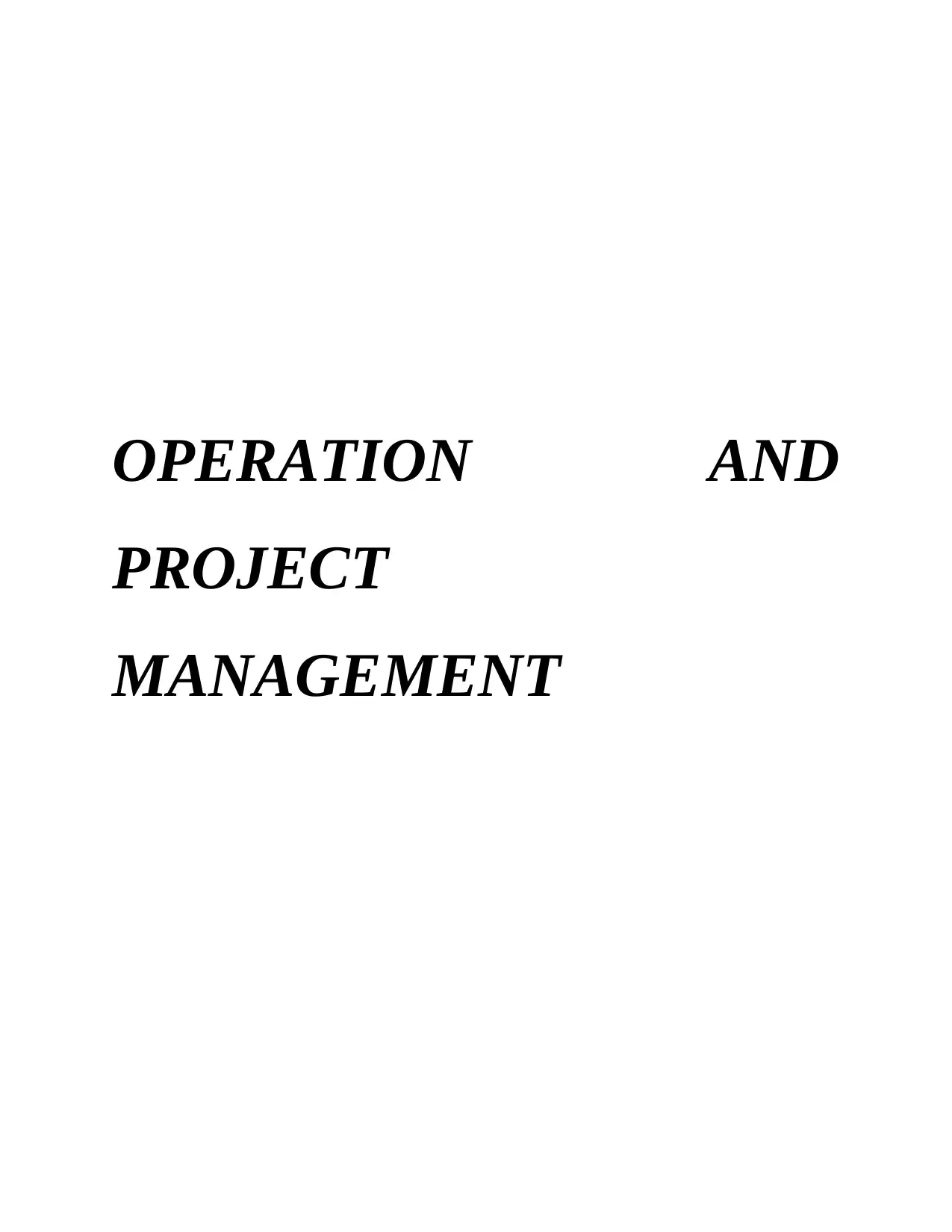
OPERATION AND
PROJECT
MANAGEMENT
PROJECT
MANAGEMENT
Paraphrase This Document
Need a fresh take? Get an instant paraphrase of this document with our AI Paraphraser
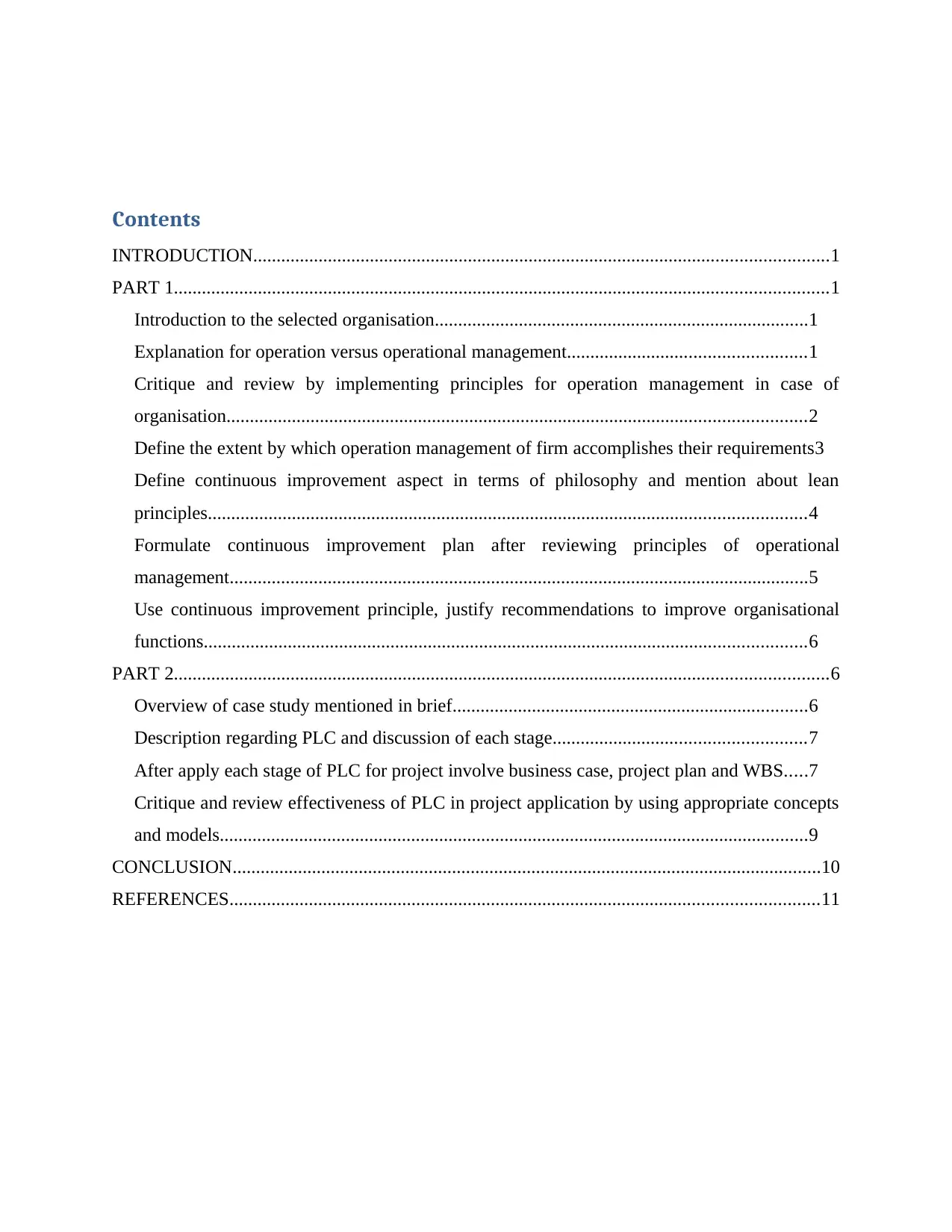
Contents
INTRODUCTION...........................................................................................................................1
PART 1............................................................................................................................................1
Introduction to the selected organisation................................................................................1
Explanation for operation versus operational management...................................................1
Critique and review by implementing principles for operation management in case of
organisation............................................................................................................................2
Define the extent by which operation management of firm accomplishes their requirements3
Define continuous improvement aspect in terms of philosophy and mention about lean
principles................................................................................................................................4
Formulate continuous improvement plan after reviewing principles of operational
management............................................................................................................................5
Use continuous improvement principle, justify recommendations to improve organisational
functions.................................................................................................................................6
PART 2............................................................................................................................................6
Overview of case study mentioned in brief............................................................................6
Description regarding PLC and discussion of each stage......................................................7
After apply each stage of PLC for project involve business case, project plan and WBS.....7
Critique and review effectiveness of PLC in project application by using appropriate concepts
and models..............................................................................................................................9
CONCLUSION..............................................................................................................................10
REFERENCES..............................................................................................................................11
INTRODUCTION...........................................................................................................................1
PART 1............................................................................................................................................1
Introduction to the selected organisation................................................................................1
Explanation for operation versus operational management...................................................1
Critique and review by implementing principles for operation management in case of
organisation............................................................................................................................2
Define the extent by which operation management of firm accomplishes their requirements3
Define continuous improvement aspect in terms of philosophy and mention about lean
principles................................................................................................................................4
Formulate continuous improvement plan after reviewing principles of operational
management............................................................................................................................5
Use continuous improvement principle, justify recommendations to improve organisational
functions.................................................................................................................................6
PART 2............................................................................................................................................6
Overview of case study mentioned in brief............................................................................6
Description regarding PLC and discussion of each stage......................................................7
After apply each stage of PLC for project involve business case, project plan and WBS.....7
Critique and review effectiveness of PLC in project application by using appropriate concepts
and models..............................................................................................................................9
CONCLUSION..............................................................................................................................10
REFERENCES..............................................................................................................................11
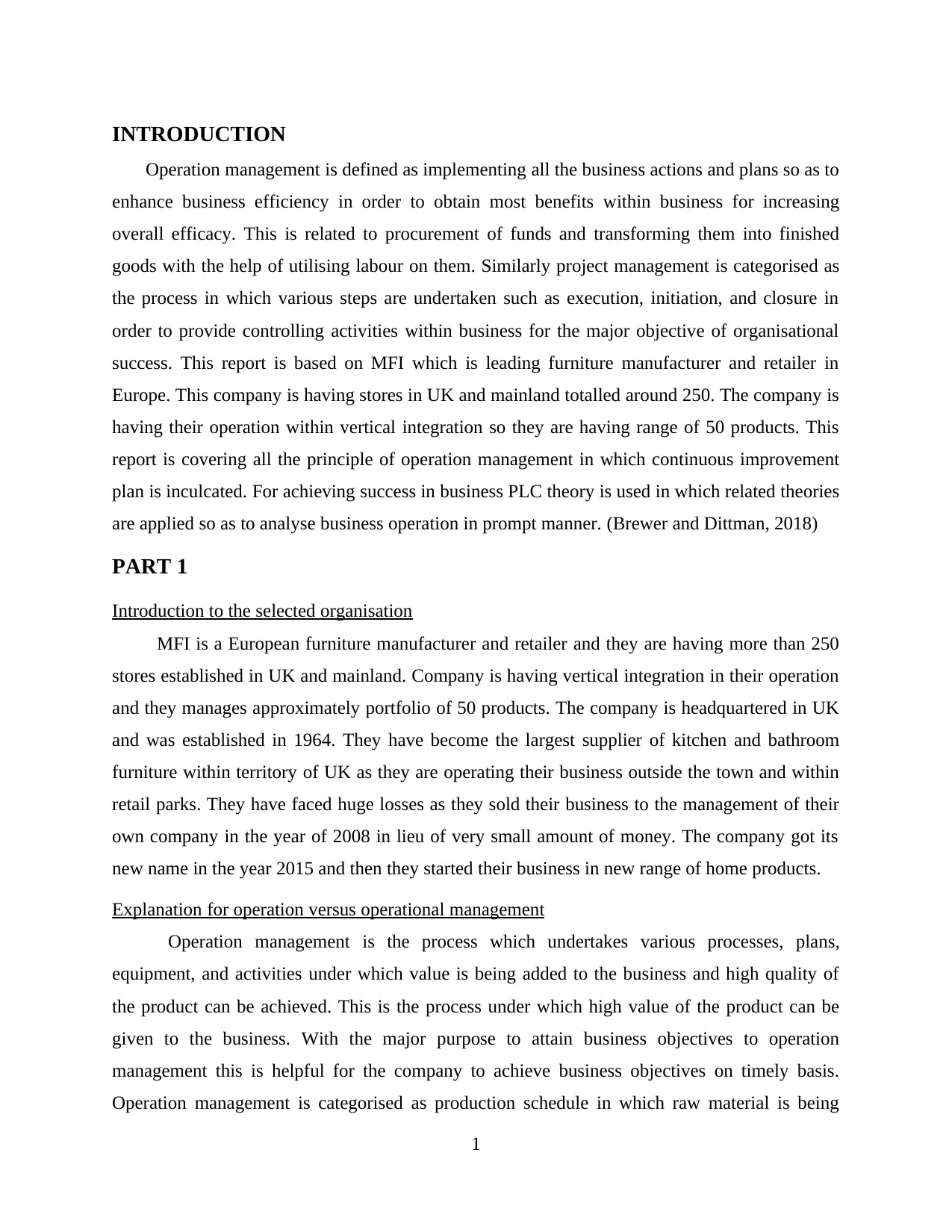
INTRODUCTION
Operation management is defined as implementing all the business actions and plans so as to
enhance business efficiency in order to obtain most benefits within business for increasing
overall efficacy. This is related to procurement of funds and transforming them into finished
goods with the help of utilising labour on them. Similarly project management is categorised as
the process in which various steps are undertaken such as execution, initiation, and closure in
order to provide controlling activities within business for the major objective of organisational
success. This report is based on MFI which is leading furniture manufacturer and retailer in
Europe. This company is having stores in UK and mainland totalled around 250. The company is
having their operation within vertical integration so they are having range of 50 products. This
report is covering all the principle of operation management in which continuous improvement
plan is inculcated. For achieving success in business PLC theory is used in which related theories
are applied so as to analyse business operation in prompt manner. (Brewer and Dittman, 2018)
PART 1
Introduction to the selected organisation
MFI is a European furniture manufacturer and retailer and they are having more than 250
stores established in UK and mainland. Company is having vertical integration in their operation
and they manages approximately portfolio of 50 products. The company is headquartered in UK
and was established in 1964. They have become the largest supplier of kitchen and bathroom
furniture within territory of UK as they are operating their business outside the town and within
retail parks. They have faced huge losses as they sold their business to the management of their
own company in the year of 2008 in lieu of very small amount of money. The company got its
new name in the year 2015 and then they started their business in new range of home products.
Explanation for operation versus operational management
Operation management is the process which undertakes various processes, plans,
equipment, and activities under which value is being added to the business and high quality of
the product can be achieved. This is the process under which high value of the product can be
given to the business. With the major purpose to attain business objectives to operation
management this is helpful for the company to achieve business objectives on timely basis.
Operation management is categorised as production schedule in which raw material is being
1
Operation management is defined as implementing all the business actions and plans so as to
enhance business efficiency in order to obtain most benefits within business for increasing
overall efficacy. This is related to procurement of funds and transforming them into finished
goods with the help of utilising labour on them. Similarly project management is categorised as
the process in which various steps are undertaken such as execution, initiation, and closure in
order to provide controlling activities within business for the major objective of organisational
success. This report is based on MFI which is leading furniture manufacturer and retailer in
Europe. This company is having stores in UK and mainland totalled around 250. The company is
having their operation within vertical integration so they are having range of 50 products. This
report is covering all the principle of operation management in which continuous improvement
plan is inculcated. For achieving success in business PLC theory is used in which related theories
are applied so as to analyse business operation in prompt manner. (Brewer and Dittman, 2018)
PART 1
Introduction to the selected organisation
MFI is a European furniture manufacturer and retailer and they are having more than 250
stores established in UK and mainland. Company is having vertical integration in their operation
and they manages approximately portfolio of 50 products. The company is headquartered in UK
and was established in 1964. They have become the largest supplier of kitchen and bathroom
furniture within territory of UK as they are operating their business outside the town and within
retail parks. They have faced huge losses as they sold their business to the management of their
own company in the year of 2008 in lieu of very small amount of money. The company got its
new name in the year 2015 and then they started their business in new range of home products.
Explanation for operation versus operational management
Operation management is the process which undertakes various processes, plans,
equipment, and activities under which value is being added to the business and high quality of
the product can be achieved. This is the process under which high value of the product can be
given to the business. With the major purpose to attain business objectives to operation
management this is helpful for the company to achieve business objectives on timely basis.
Operation management is categorised as production schedule in which raw material is being
1
⊘ This is a preview!⊘
Do you want full access?
Subscribe today to unlock all pages.

Trusted by 1+ million students worldwide
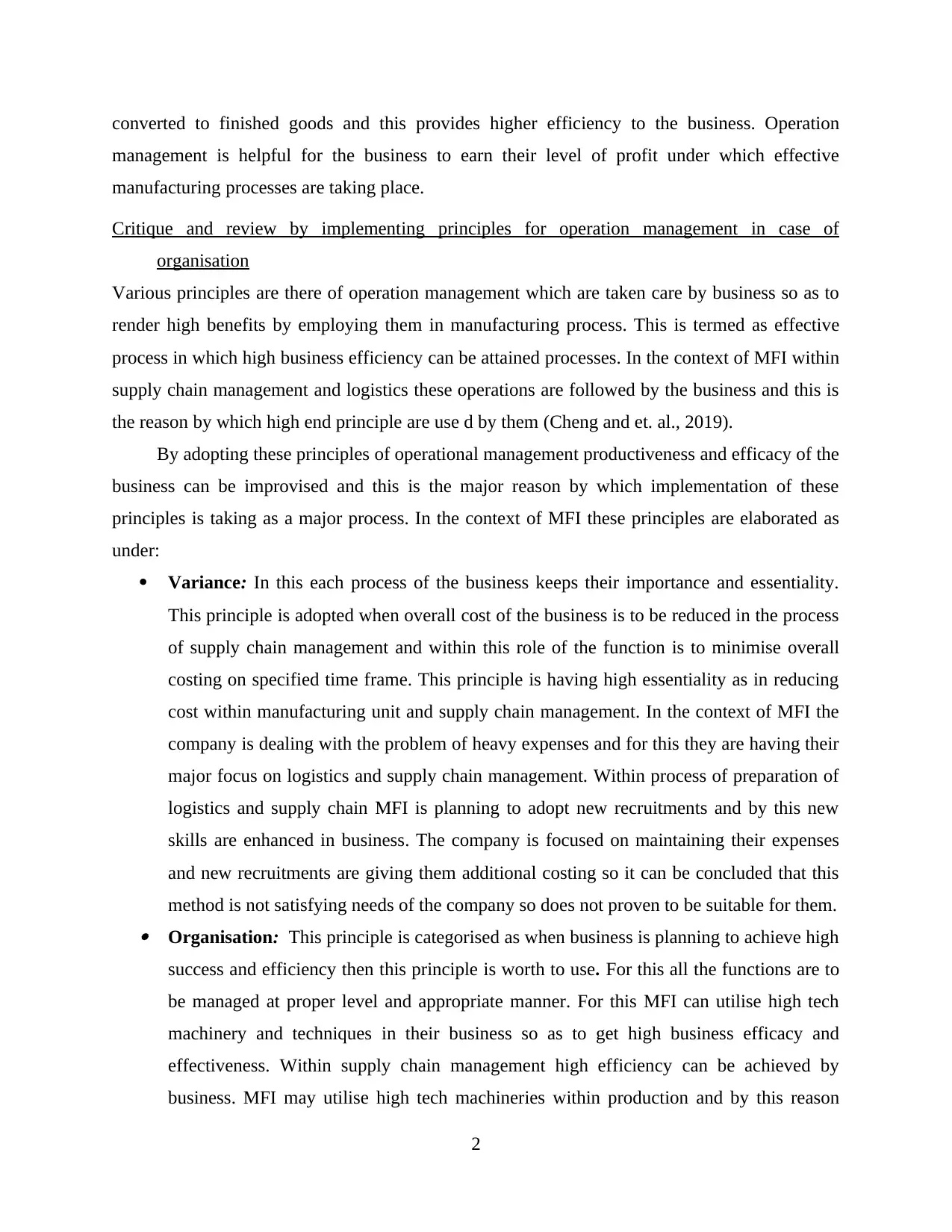
converted to finished goods and this provides higher efficiency to the business. Operation
management is helpful for the business to earn their level of profit under which effective
manufacturing processes are taking place.
Critique and review by implementing principles for operation management in case of
organisation
Various principles are there of operation management which are taken care by business so as to
render high benefits by employing them in manufacturing process. This is termed as effective
process in which high business efficiency can be attained processes. In the context of MFI within
supply chain management and logistics these operations are followed by the business and this is
the reason by which high end principle are use d by them (Cheng and et. al., 2019).
By adopting these principles of operational management productiveness and efficacy of the
business can be improvised and this is the major reason by which implementation of these
principles is taking as a major process. In the context of MFI these principles are elaborated as
under:
Variance: In this each process of the business keeps their importance and essentiality.
This principle is adopted when overall cost of the business is to be reduced in the process
of supply chain management and within this role of the function is to minimise overall
costing on specified time frame. This principle is having high essentiality as in reducing
cost within manufacturing unit and supply chain management. In the context of MFI the
company is dealing with the problem of heavy expenses and for this they are having their
major focus on logistics and supply chain management. Within process of preparation of
logistics and supply chain MFI is planning to adopt new recruitments and by this new
skills are enhanced in business. The company is focused on maintaining their expenses
and new recruitments are giving them additional costing so it can be concluded that this
method is not satisfying needs of the company so does not proven to be suitable for them. Organisation: This principle is categorised as when business is planning to achieve high
success and efficiency then this principle is worth to use. For this all the functions are to
be managed at proper level and appropriate manner. For this MFI can utilise high tech
machinery and techniques in their business so as to get high business efficacy and
effectiveness. Within supply chain management high efficiency can be achieved by
business. MFI may utilise high tech machineries within production and by this reason
2
management is helpful for the business to earn their level of profit under which effective
manufacturing processes are taking place.
Critique and review by implementing principles for operation management in case of
organisation
Various principles are there of operation management which are taken care by business so as to
render high benefits by employing them in manufacturing process. This is termed as effective
process in which high business efficiency can be attained processes. In the context of MFI within
supply chain management and logistics these operations are followed by the business and this is
the reason by which high end principle are use d by them (Cheng and et. al., 2019).
By adopting these principles of operational management productiveness and efficacy of the
business can be improvised and this is the major reason by which implementation of these
principles is taking as a major process. In the context of MFI these principles are elaborated as
under:
Variance: In this each process of the business keeps their importance and essentiality.
This principle is adopted when overall cost of the business is to be reduced in the process
of supply chain management and within this role of the function is to minimise overall
costing on specified time frame. This principle is having high essentiality as in reducing
cost within manufacturing unit and supply chain management. In the context of MFI the
company is dealing with the problem of heavy expenses and for this they are having their
major focus on logistics and supply chain management. Within process of preparation of
logistics and supply chain MFI is planning to adopt new recruitments and by this new
skills are enhanced in business. The company is focused on maintaining their expenses
and new recruitments are giving them additional costing so it can be concluded that this
method is not satisfying needs of the company so does not proven to be suitable for them. Organisation: This principle is categorised as when business is planning to achieve high
success and efficiency then this principle is worth to use. For this all the functions are to
be managed at proper level and appropriate manner. For this MFI can utilise high tech
machinery and techniques in their business so as to get high business efficacy and
effectiveness. Within supply chain management high efficiency can be achieved by
business. MFI may utilise high tech machineries within production and by this reason
2
Paraphrase This Document
Need a fresh take? Get an instant paraphrase of this document with our AI Paraphraser
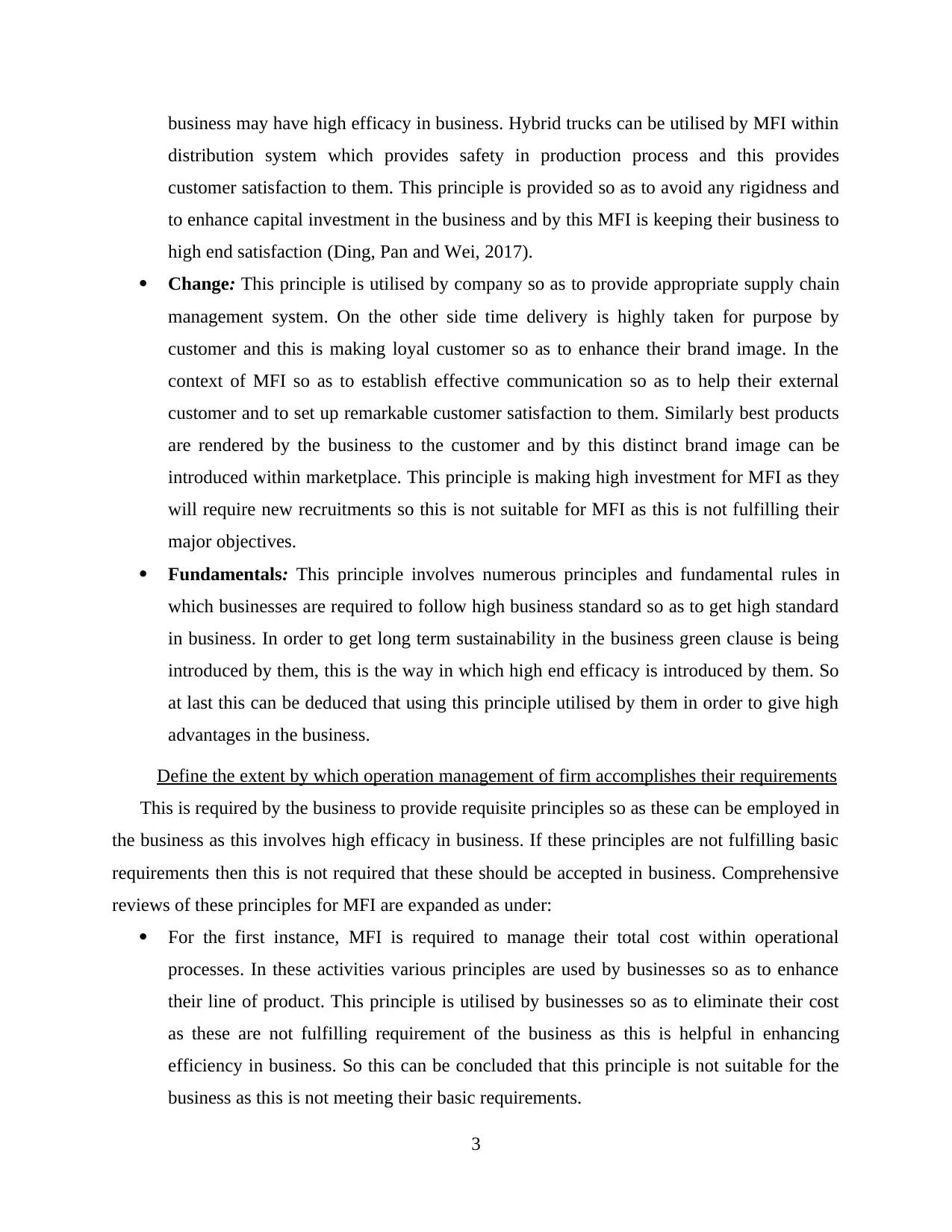
business may have high efficacy in business. Hybrid trucks can be utilised by MFI within
distribution system which provides safety in production process and this provides
customer satisfaction to them. This principle is provided so as to avoid any rigidness and
to enhance capital investment in the business and by this MFI is keeping their business to
high end satisfaction (Ding, Pan and Wei, 2017).
Change: This principle is utilised by company so as to provide appropriate supply chain
management system. On the other side time delivery is highly taken for purpose by
customer and this is making loyal customer so as to enhance their brand image. In the
context of MFI so as to establish effective communication so as to help their external
customer and to set up remarkable customer satisfaction to them. Similarly best products
are rendered by the business to the customer and by this distinct brand image can be
introduced within marketplace. This principle is making high investment for MFI as they
will require new recruitments so this is not suitable for MFI as this is not fulfilling their
major objectives.
Fundamentals: This principle involves numerous principles and fundamental rules in
which businesses are required to follow high business standard so as to get high standard
in business. In order to get long term sustainability in the business green clause is being
introduced by them, this is the way in which high end efficacy is introduced by them. So
at last this can be deduced that using this principle utilised by them in order to give high
advantages in the business.
Define the extent by which operation management of firm accomplishes their requirements
This is required by the business to provide requisite principles so as these can be employed in
the business as this involves high efficacy in business. If these principles are not fulfilling basic
requirements then this is not required that these should be accepted in business. Comprehensive
reviews of these principles for MFI are expanded as under:
For the first instance, MFI is required to manage their total cost within operational
processes. In these activities various principles are used by businesses so as to enhance
their line of product. This principle is utilised by businesses so as to eliminate their cost
as these are not fulfilling requirement of the business as this is helpful in enhancing
efficiency in business. So this can be concluded that this principle is not suitable for the
business as this is not meeting their basic requirements.
3
distribution system which provides safety in production process and this provides
customer satisfaction to them. This principle is provided so as to avoid any rigidness and
to enhance capital investment in the business and by this MFI is keeping their business to
high end satisfaction (Ding, Pan and Wei, 2017).
Change: This principle is utilised by company so as to provide appropriate supply chain
management system. On the other side time delivery is highly taken for purpose by
customer and this is making loyal customer so as to enhance their brand image. In the
context of MFI so as to establish effective communication so as to help their external
customer and to set up remarkable customer satisfaction to them. Similarly best products
are rendered by the business to the customer and by this distinct brand image can be
introduced within marketplace. This principle is making high investment for MFI as they
will require new recruitments so this is not suitable for MFI as this is not fulfilling their
major objectives.
Fundamentals: This principle involves numerous principles and fundamental rules in
which businesses are required to follow high business standard so as to get high standard
in business. In order to get long term sustainability in the business green clause is being
introduced by them, this is the way in which high end efficacy is introduced by them. So
at last this can be deduced that using this principle utilised by them in order to give high
advantages in the business.
Define the extent by which operation management of firm accomplishes their requirements
This is required by the business to provide requisite principles so as these can be employed in
the business as this involves high efficacy in business. If these principles are not fulfilling basic
requirements then this is not required that these should be accepted in business. Comprehensive
reviews of these principles for MFI are expanded as under:
For the first instance, MFI is required to manage their total cost within operational
processes. In these activities various principles are used by businesses so as to enhance
their line of product. This principle is utilised by businesses so as to eliminate their cost
as these are not fulfilling requirement of the business as this is helpful in enhancing
efficiency in business. So this can be concluded that this principle is not suitable for the
business as this is not meeting their basic requirements.
3
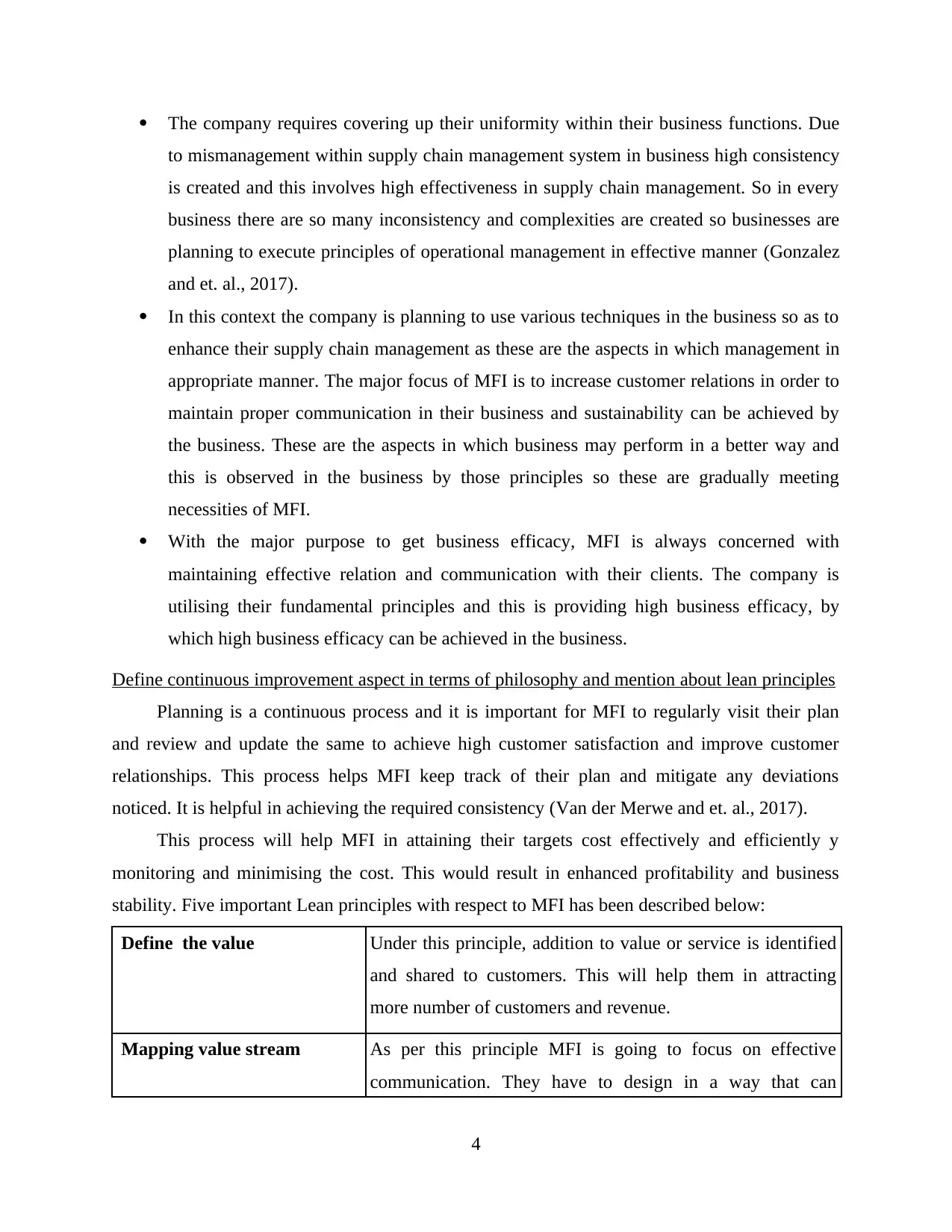
The company requires covering up their uniformity within their business functions. Due
to mismanagement within supply chain management system in business high consistency
is created and this involves high effectiveness in supply chain management. So in every
business there are so many inconsistency and complexities are created so businesses are
planning to execute principles of operational management in effective manner (Gonzalez
and et. al., 2017).
In this context the company is planning to use various techniques in the business so as to
enhance their supply chain management as these are the aspects in which management in
appropriate manner. The major focus of MFI is to increase customer relations in order to
maintain proper communication in their business and sustainability can be achieved by
the business. These are the aspects in which business may perform in a better way and
this is observed in the business by those principles so these are gradually meeting
necessities of MFI.
With the major purpose to get business efficacy, MFI is always concerned with
maintaining effective relation and communication with their clients. The company is
utilising their fundamental principles and this is providing high business efficacy, by
which high business efficacy can be achieved in the business.
Define continuous improvement aspect in terms of philosophy and mention about lean principles
Planning is a continuous process and it is important for MFI to regularly visit their plan
and review and update the same to achieve high customer satisfaction and improve customer
relationships. This process helps MFI keep track of their plan and mitigate any deviations
noticed. It is helpful in achieving the required consistency (Van der Merwe and et. al., 2017).
This process will help MFI in attaining their targets cost effectively and efficiently y
monitoring and minimising the cost. This would result in enhanced profitability and business
stability. Five important Lean principles with respect to MFI has been described below:
Define the value Under this principle, addition to value or service is identified
and shared to customers. This will help them in attracting
more number of customers and revenue.
Mapping value stream As per this principle MFI is going to focus on effective
communication. They have to design in a way that can
4
to mismanagement within supply chain management system in business high consistency
is created and this involves high effectiveness in supply chain management. So in every
business there are so many inconsistency and complexities are created so businesses are
planning to execute principles of operational management in effective manner (Gonzalez
and et. al., 2017).
In this context the company is planning to use various techniques in the business so as to
enhance their supply chain management as these are the aspects in which management in
appropriate manner. The major focus of MFI is to increase customer relations in order to
maintain proper communication in their business and sustainability can be achieved by
the business. These are the aspects in which business may perform in a better way and
this is observed in the business by those principles so these are gradually meeting
necessities of MFI.
With the major purpose to get business efficacy, MFI is always concerned with
maintaining effective relation and communication with their clients. The company is
utilising their fundamental principles and this is providing high business efficacy, by
which high business efficacy can be achieved in the business.
Define continuous improvement aspect in terms of philosophy and mention about lean principles
Planning is a continuous process and it is important for MFI to regularly visit their plan
and review and update the same to achieve high customer satisfaction and improve customer
relationships. This process helps MFI keep track of their plan and mitigate any deviations
noticed. It is helpful in achieving the required consistency (Van der Merwe and et. al., 2017).
This process will help MFI in attaining their targets cost effectively and efficiently y
monitoring and minimising the cost. This would result in enhanced profitability and business
stability. Five important Lean principles with respect to MFI has been described below:
Define the value Under this principle, addition to value or service is identified
and shared to customers. This will help them in attracting
more number of customers and revenue.
Mapping value stream As per this principle MFI is going to focus on effective
communication. They have to design in a way that can
4
⊘ This is a preview!⊘
Do you want full access?
Subscribe today to unlock all pages.

Trusted by 1+ million students worldwide
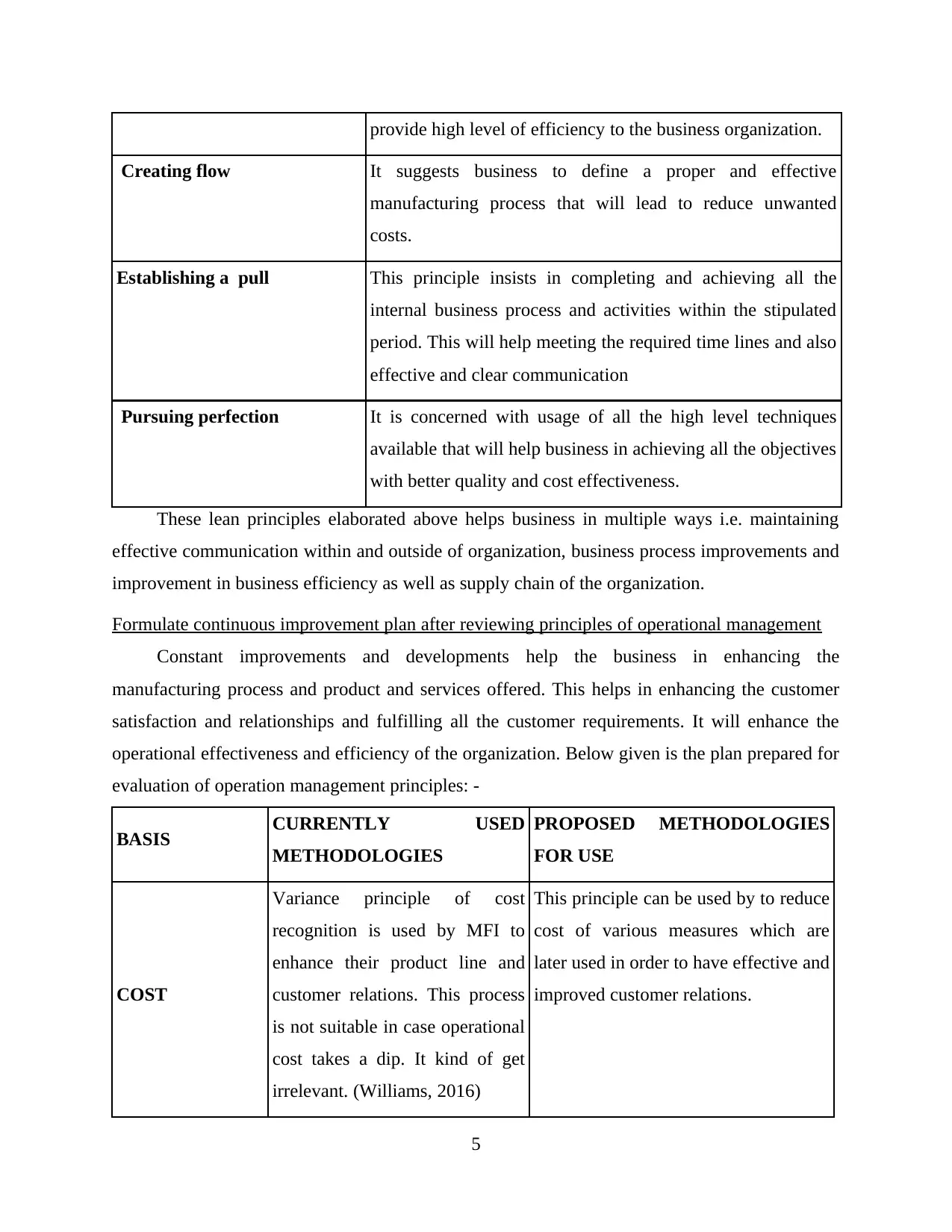
provide high level of efficiency to the business organization.
Creating flow It suggests business to define a proper and effective
manufacturing process that will lead to reduce unwanted
costs.
Establishing a pull This principle insists in completing and achieving all the
internal business process and activities within the stipulated
period. This will help meeting the required time lines and also
effective and clear communication
Pursuing perfection It is concerned with usage of all the high level techniques
available that will help business in achieving all the objectives
with better quality and cost effectiveness.
These lean principles elaborated above helps business in multiple ways i.e. maintaining
effective communication within and outside of organization, business process improvements and
improvement in business efficiency as well as supply chain of the organization.
Formulate continuous improvement plan after reviewing principles of operational management
Constant improvements and developments help the business in enhancing the
manufacturing process and product and services offered. This helps in enhancing the customer
satisfaction and relationships and fulfilling all the customer requirements. It will enhance the
operational effectiveness and efficiency of the organization. Below given is the plan prepared for
evaluation of operation management principles: -
BASIS CURRENTLY USED
METHODOLOGIES
PROPOSED METHODOLOGIES
FOR USE
COST
Variance principle of cost
recognition is used by MFI to
enhance their product line and
customer relations. This process
is not suitable in case operational
cost takes a dip. It kind of get
irrelevant. (Williams, 2016)
This principle can be used by to reduce
cost of various measures which are
later used in order to have effective and
improved customer relations.
5
Creating flow It suggests business to define a proper and effective
manufacturing process that will lead to reduce unwanted
costs.
Establishing a pull This principle insists in completing and achieving all the
internal business process and activities within the stipulated
period. This will help meeting the required time lines and also
effective and clear communication
Pursuing perfection It is concerned with usage of all the high level techniques
available that will help business in achieving all the objectives
with better quality and cost effectiveness.
These lean principles elaborated above helps business in multiple ways i.e. maintaining
effective communication within and outside of organization, business process improvements and
improvement in business efficiency as well as supply chain of the organization.
Formulate continuous improvement plan after reviewing principles of operational management
Constant improvements and developments help the business in enhancing the
manufacturing process and product and services offered. This helps in enhancing the customer
satisfaction and relationships and fulfilling all the customer requirements. It will enhance the
operational effectiveness and efficiency of the organization. Below given is the plan prepared for
evaluation of operation management principles: -
BASIS CURRENTLY USED
METHODOLOGIES
PROPOSED METHODOLOGIES
FOR USE
COST
Variance principle of cost
recognition is used by MFI to
enhance their product line and
customer relations. This process
is not suitable in case operational
cost takes a dip. It kind of get
irrelevant. (Williams, 2016)
This principle can be used by to reduce
cost of various measures which are
later used in order to have effective and
improved customer relations.
5
Paraphrase This Document
Need a fresh take? Get an instant paraphrase of this document with our AI Paraphraser
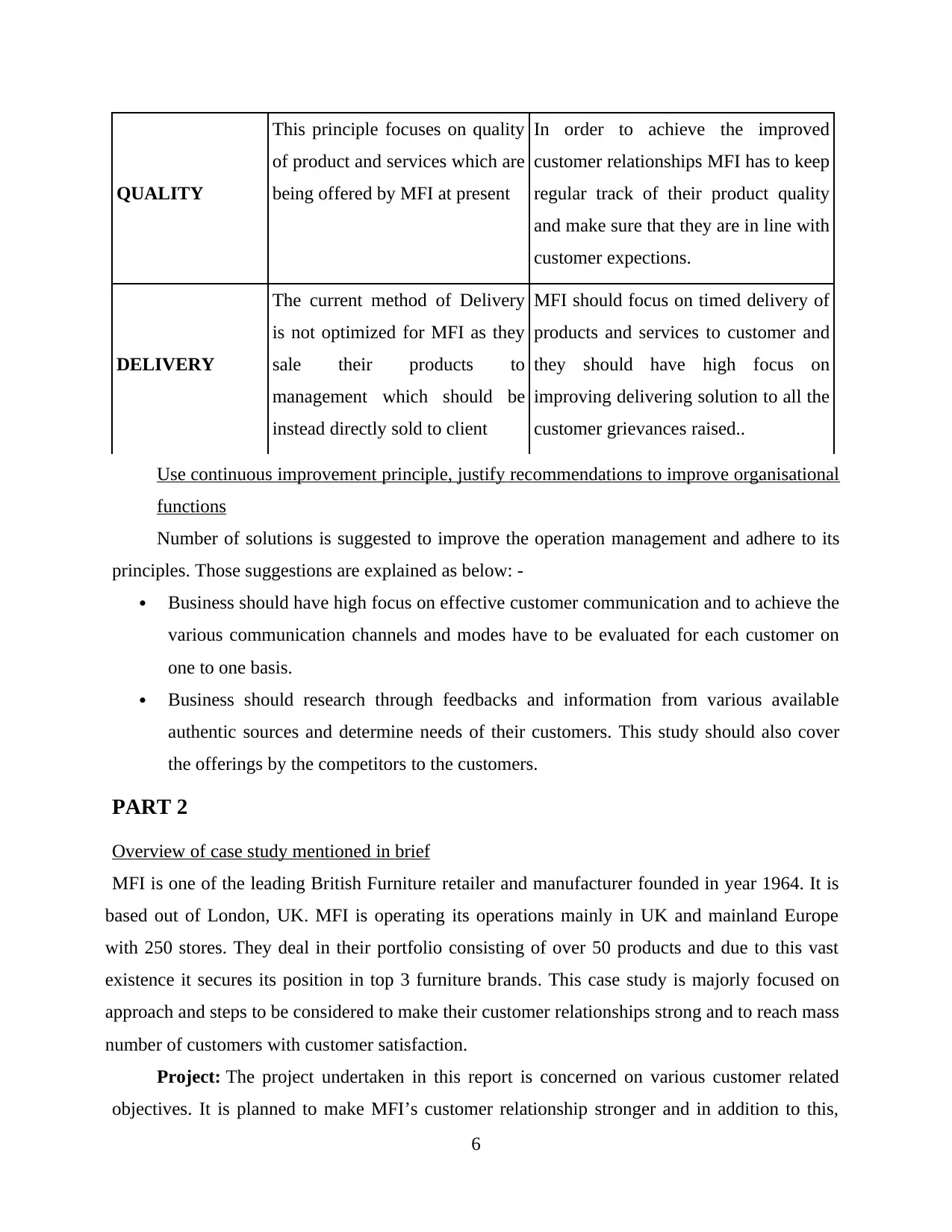
QUALITY
This principle focuses on quality
of product and services which are
being offered by MFI at present
In order to achieve the improved
customer relationships MFI has to keep
regular track of their product quality
and make sure that they are in line with
customer expections.
DELIVERY
The current method of Delivery
is not optimized for MFI as they
sale their products to
management which should be
instead directly sold to client
MFI should focus on timed delivery of
products and services to customer and
they should have high focus on
improving delivering solution to all the
customer grievances raised..
Use continuous improvement principle, justify recommendations to improve organisational
functions
Number of solutions is suggested to improve the operation management and adhere to its
principles. Those suggestions are explained as below: -
Business should have high focus on effective customer communication and to achieve the
various communication channels and modes have to be evaluated for each customer on
one to one basis.
Business should research through feedbacks and information from various available
authentic sources and determine needs of their customers. This study should also cover
the offerings by the competitors to the customers.
PART 2
Overview of case study mentioned in brief
MFI is one of the leading British Furniture retailer and manufacturer founded in year 1964. It is
based out of London, UK. MFI is operating its operations mainly in UK and mainland Europe
with 250 stores. They deal in their portfolio consisting of over 50 products and due to this vast
existence it secures its position in top 3 furniture brands. This case study is majorly focused on
approach and steps to be considered to make their customer relationships strong and to reach mass
number of customers with customer satisfaction.
Project: The project undertaken in this report is concerned on various customer related
objectives. It is planned to make MFI’s customer relationship stronger and in addition to this,
6
This principle focuses on quality
of product and services which are
being offered by MFI at present
In order to achieve the improved
customer relationships MFI has to keep
regular track of their product quality
and make sure that they are in line with
customer expections.
DELIVERY
The current method of Delivery
is not optimized for MFI as they
sale their products to
management which should be
instead directly sold to client
MFI should focus on timed delivery of
products and services to customer and
they should have high focus on
improving delivering solution to all the
customer grievances raised..
Use continuous improvement principle, justify recommendations to improve organisational
functions
Number of solutions is suggested to improve the operation management and adhere to its
principles. Those suggestions are explained as below: -
Business should have high focus on effective customer communication and to achieve the
various communication channels and modes have to be evaluated for each customer on
one to one basis.
Business should research through feedbacks and information from various available
authentic sources and determine needs of their customers. This study should also cover
the offerings by the competitors to the customers.
PART 2
Overview of case study mentioned in brief
MFI is one of the leading British Furniture retailer and manufacturer founded in year 1964. It is
based out of London, UK. MFI is operating its operations mainly in UK and mainland Europe
with 250 stores. They deal in their portfolio consisting of over 50 products and due to this vast
existence it secures its position in top 3 furniture brands. This case study is majorly focused on
approach and steps to be considered to make their customer relationships strong and to reach mass
number of customers with customer satisfaction.
Project: The project undertaken in this report is concerned on various customer related
objectives. It is planned to make MFI’s customer relationship stronger and in addition to this,
6
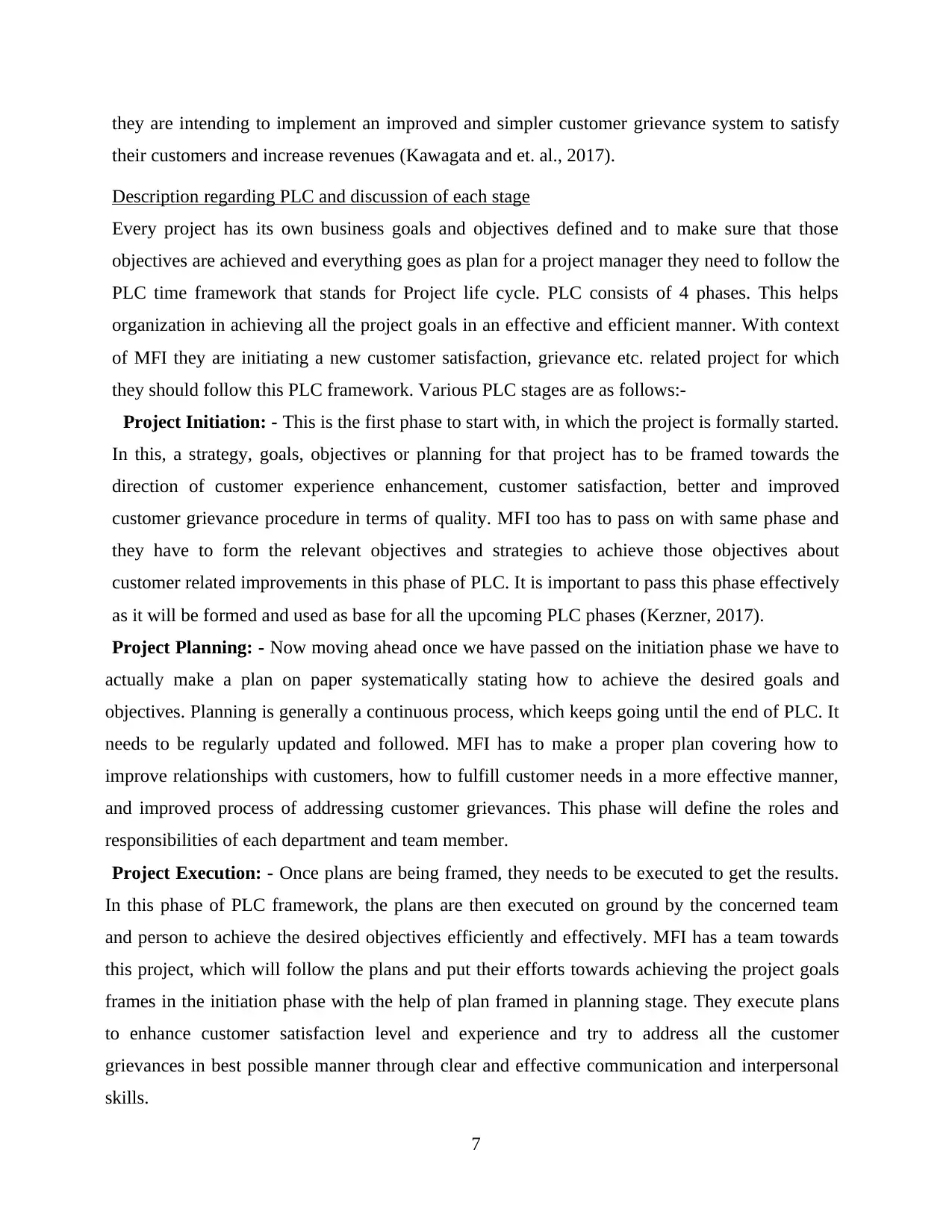
they are intending to implement an improved and simpler customer grievance system to satisfy
their customers and increase revenues (Kawagata and et. al., 2017).
Description regarding PLC and discussion of each stage
Every project has its own business goals and objectives defined and to make sure that those
objectives are achieved and everything goes as plan for a project manager they need to follow the
PLC time framework that stands for Project life cycle. PLC consists of 4 phases. This helps
organization in achieving all the project goals in an effective and efficient manner. With context
of MFI they are initiating a new customer satisfaction, grievance etc. related project for which
they should follow this PLC framework. Various PLC stages are as follows:-
Project Initiation: - This is the first phase to start with, in which the project is formally started.
In this, a strategy, goals, objectives or planning for that project has to be framed towards the
direction of customer experience enhancement, customer satisfaction, better and improved
customer grievance procedure in terms of quality. MFI too has to pass on with same phase and
they have to form the relevant objectives and strategies to achieve those objectives about
customer related improvements in this phase of PLC. It is important to pass this phase effectively
as it will be formed and used as base for all the upcoming PLC phases (Kerzner, 2017).
Project Planning: - Now moving ahead once we have passed on the initiation phase we have to
actually make a plan on paper systematically stating how to achieve the desired goals and
objectives. Planning is generally a continuous process, which keeps going until the end of PLC. It
needs to be regularly updated and followed. MFI has to make a proper plan covering how to
improve relationships with customers, how to fulfill customer needs in a more effective manner,
and improved process of addressing customer grievances. This phase will define the roles and
responsibilities of each department and team member.
Project Execution: - Once plans are being framed, they needs to be executed to get the results.
In this phase of PLC framework, the plans are then executed on ground by the concerned team
and person to achieve the desired objectives efficiently and effectively. MFI has a team towards
this project, which will follow the plans and put their efforts towards achieving the project goals
frames in the initiation phase with the help of plan framed in planning stage. They execute plans
to enhance customer satisfaction level and experience and try to address all the customer
grievances in best possible manner through clear and effective communication and interpersonal
skills.
7
their customers and increase revenues (Kawagata and et. al., 2017).
Description regarding PLC and discussion of each stage
Every project has its own business goals and objectives defined and to make sure that those
objectives are achieved and everything goes as plan for a project manager they need to follow the
PLC time framework that stands for Project life cycle. PLC consists of 4 phases. This helps
organization in achieving all the project goals in an effective and efficient manner. With context
of MFI they are initiating a new customer satisfaction, grievance etc. related project for which
they should follow this PLC framework. Various PLC stages are as follows:-
Project Initiation: - This is the first phase to start with, in which the project is formally started.
In this, a strategy, goals, objectives or planning for that project has to be framed towards the
direction of customer experience enhancement, customer satisfaction, better and improved
customer grievance procedure in terms of quality. MFI too has to pass on with same phase and
they have to form the relevant objectives and strategies to achieve those objectives about
customer related improvements in this phase of PLC. It is important to pass this phase effectively
as it will be formed and used as base for all the upcoming PLC phases (Kerzner, 2017).
Project Planning: - Now moving ahead once we have passed on the initiation phase we have to
actually make a plan on paper systematically stating how to achieve the desired goals and
objectives. Planning is generally a continuous process, which keeps going until the end of PLC. It
needs to be regularly updated and followed. MFI has to make a proper plan covering how to
improve relationships with customers, how to fulfill customer needs in a more effective manner,
and improved process of addressing customer grievances. This phase will define the roles and
responsibilities of each department and team member.
Project Execution: - Once plans are being framed, they needs to be executed to get the results.
In this phase of PLC framework, the plans are then executed on ground by the concerned team
and person to achieve the desired objectives efficiently and effectively. MFI has a team towards
this project, which will follow the plans and put their efforts towards achieving the project goals
frames in the initiation phase with the help of plan framed in planning stage. They execute plans
to enhance customer satisfaction level and experience and try to address all the customer
grievances in best possible manner through clear and effective communication and interpersonal
skills.
7
⊘ This is a preview!⊘
Do you want full access?
Subscribe today to unlock all pages.

Trusted by 1+ million students worldwide
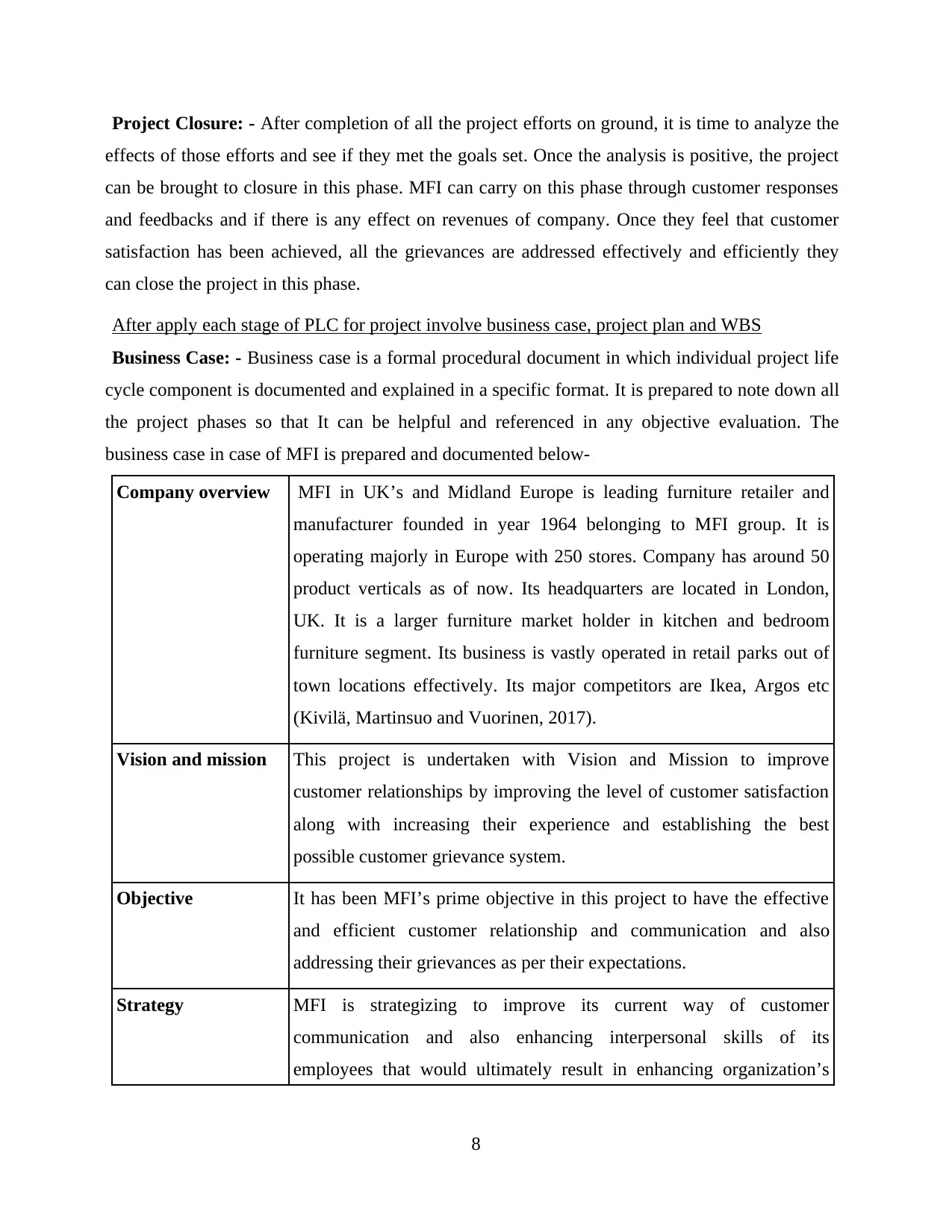
Project Closure: - After completion of all the project efforts on ground, it is time to analyze the
effects of those efforts and see if they met the goals set. Once the analysis is positive, the project
can be brought to closure in this phase. MFI can carry on this phase through customer responses
and feedbacks and if there is any effect on revenues of company. Once they feel that customer
satisfaction has been achieved, all the grievances are addressed effectively and efficiently they
can close the project in this phase.
After apply each stage of PLC for project involve business case, project plan and WBS
Business Case: - Business case is a formal procedural document in which individual project life
cycle component is documented and explained in a specific format. It is prepared to note down all
the project phases so that It can be helpful and referenced in any objective evaluation. The
business case in case of MFI is prepared and documented below-
Company overview MFI in UK’s and Midland Europe is leading furniture retailer and
manufacturer founded in year 1964 belonging to MFI group. It is
operating majorly in Europe with 250 stores. Company has around 50
product verticals as of now. Its headquarters are located in London,
UK. It is a larger furniture market holder in kitchen and bedroom
furniture segment. Its business is vastly operated in retail parks out of
town locations effectively. Its major competitors are Ikea, Argos etc
(Kivilä, Martinsuo and Vuorinen, 2017).
Vision and mission This project is undertaken with Vision and Mission to improve
customer relationships by improving the level of customer satisfaction
along with increasing their experience and establishing the best
possible customer grievance system.
Objective It has been MFI’s prime objective in this project to have the effective
and efficient customer relationship and communication and also
addressing their grievances as per their expectations.
Strategy MFI is strategizing to improve its current way of customer
communication and also enhancing interpersonal skills of its
employees that would ultimately result in enhancing organization’s
8
effects of those efforts and see if they met the goals set. Once the analysis is positive, the project
can be brought to closure in this phase. MFI can carry on this phase through customer responses
and feedbacks and if there is any effect on revenues of company. Once they feel that customer
satisfaction has been achieved, all the grievances are addressed effectively and efficiently they
can close the project in this phase.
After apply each stage of PLC for project involve business case, project plan and WBS
Business Case: - Business case is a formal procedural document in which individual project life
cycle component is documented and explained in a specific format. It is prepared to note down all
the project phases so that It can be helpful and referenced in any objective evaluation. The
business case in case of MFI is prepared and documented below-
Company overview MFI in UK’s and Midland Europe is leading furniture retailer and
manufacturer founded in year 1964 belonging to MFI group. It is
operating majorly in Europe with 250 stores. Company has around 50
product verticals as of now. Its headquarters are located in London,
UK. It is a larger furniture market holder in kitchen and bedroom
furniture segment. Its business is vastly operated in retail parks out of
town locations effectively. Its major competitors are Ikea, Argos etc
(Kivilä, Martinsuo and Vuorinen, 2017).
Vision and mission This project is undertaken with Vision and Mission to improve
customer relationships by improving the level of customer satisfaction
along with increasing their experience and establishing the best
possible customer grievance system.
Objective It has been MFI’s prime objective in this project to have the effective
and efficient customer relationship and communication and also
addressing their grievances as per their expectations.
Strategy MFI is strategizing to improve its current way of customer
communication and also enhancing interpersonal skills of its
employees that would ultimately result in enhancing organization’s
8
Paraphrase This Document
Need a fresh take? Get an instant paraphrase of this document with our AI Paraphraser
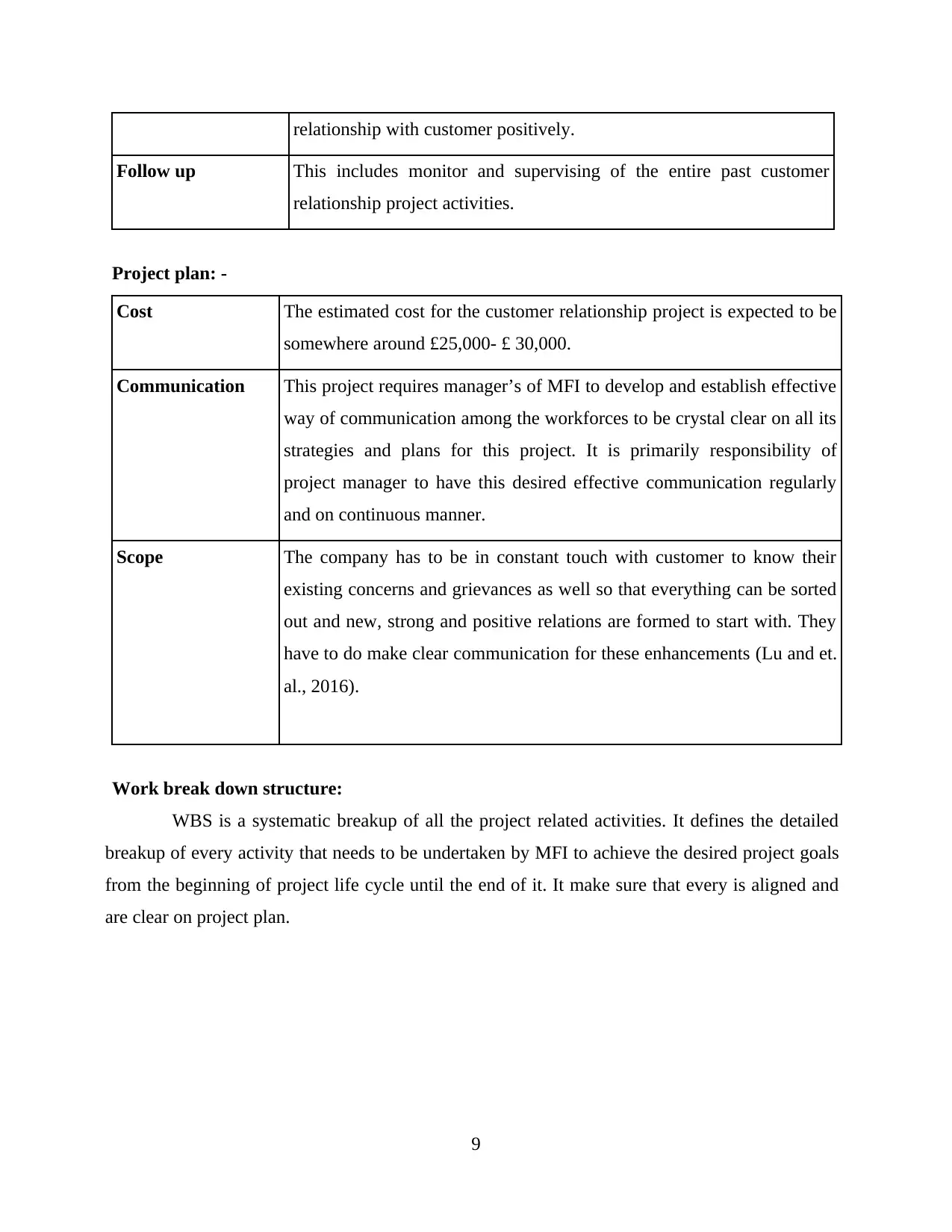
relationship with customer positively.
Follow up This includes monitor and supervising of the entire past customer
relationship project activities.
Project plan: -
Cost The estimated cost for the customer relationship project is expected to be
somewhere around £25,000- £ 30,000.
Communication This project requires manager’s of MFI to develop and establish effective
way of communication among the workforces to be crystal clear on all its
strategies and plans for this project. It is primarily responsibility of
project manager to have this desired effective communication regularly
and on continuous manner.
Scope The company has to be in constant touch with customer to know their
existing concerns and grievances as well so that everything can be sorted
out and new, strong and positive relations are formed to start with. They
have to do make clear communication for these enhancements (Lu and et.
al., 2016).
Work break down structure:
WBS is a systematic breakup of all the project related activities. It defines the detailed
breakup of every activity that needs to be undertaken by MFI to achieve the desired project goals
from the beginning of project life cycle until the end of it. It make sure that every is aligned and
are clear on project plan.
9
Follow up This includes monitor and supervising of the entire past customer
relationship project activities.
Project plan: -
Cost The estimated cost for the customer relationship project is expected to be
somewhere around £25,000- £ 30,000.
Communication This project requires manager’s of MFI to develop and establish effective
way of communication among the workforces to be crystal clear on all its
strategies and plans for this project. It is primarily responsibility of
project manager to have this desired effective communication regularly
and on continuous manner.
Scope The company has to be in constant touch with customer to know their
existing concerns and grievances as well so that everything can be sorted
out and new, strong and positive relations are formed to start with. They
have to do make clear communication for these enhancements (Lu and et.
al., 2016).
Work break down structure:
WBS is a systematic breakup of all the project related activities. It defines the detailed
breakup of every activity that needs to be undertaken by MFI to achieve the desired project goals
from the beginning of project life cycle until the end of it. It make sure that every is aligned and
are clear on project plan.
9
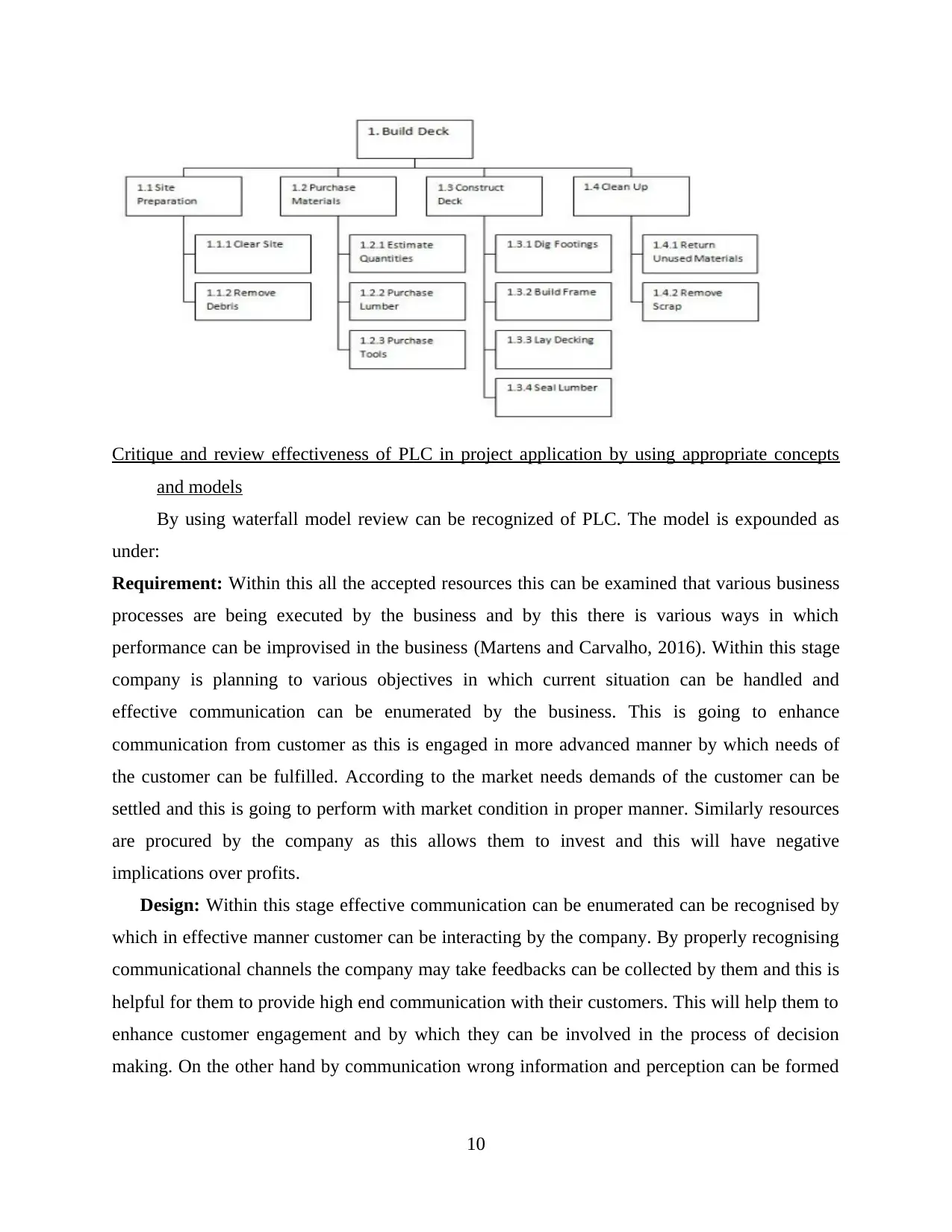
Critique and review effectiveness of PLC in project application by using appropriate concepts
and models
By using waterfall model review can be recognized of PLC. The model is expounded as
under:
Requirement: Within this all the accepted resources this can be examined that various business
processes are being executed by the business and by this there is various ways in which
performance can be improvised in the business (Martens and Carvalho, 2016). Within this stage
company is planning to various objectives in which current situation can be handled and
effective communication can be enumerated by the business. This is going to enhance
communication from customer as this is engaged in more advanced manner by which needs of
the customer can be fulfilled. According to the market needs demands of the customer can be
settled and this is going to perform with market condition in proper manner. Similarly resources
are procured by the company as this allows them to invest and this will have negative
implications over profits.
Design: Within this stage effective communication can be enumerated can be recognised by
which in effective manner customer can be interacting by the company. By properly recognising
communicational channels the company may take feedbacks can be collected by them and this is
helpful for them to provide high end communication with their customers. This will help them to
enhance customer engagement and by which they can be involved in the process of decision
making. On the other hand by communication wrong information and perception can be formed
10
and models
By using waterfall model review can be recognized of PLC. The model is expounded as
under:
Requirement: Within this all the accepted resources this can be examined that various business
processes are being executed by the business and by this there is various ways in which
performance can be improvised in the business (Martens and Carvalho, 2016). Within this stage
company is planning to various objectives in which current situation can be handled and
effective communication can be enumerated by the business. This is going to enhance
communication from customer as this is engaged in more advanced manner by which needs of
the customer can be fulfilled. According to the market needs demands of the customer can be
settled and this is going to perform with market condition in proper manner. Similarly resources
are procured by the company as this allows them to invest and this will have negative
implications over profits.
Design: Within this stage effective communication can be enumerated can be recognised by
which in effective manner customer can be interacting by the company. By properly recognising
communicational channels the company may take feedbacks can be collected by them and this is
helpful for them to provide high end communication with their customers. This will help them to
enhance customer engagement and by which they can be involved in the process of decision
making. On the other hand by communication wrong information and perception can be formed
10
⊘ This is a preview!⊘
Do you want full access?
Subscribe today to unlock all pages.

Trusted by 1+ million students worldwide
1 out of 14
Related Documents
Your All-in-One AI-Powered Toolkit for Academic Success.
+13062052269
info@desklib.com
Available 24*7 on WhatsApp / Email
![[object Object]](/_next/static/media/star-bottom.7253800d.svg)
Unlock your academic potential
Copyright © 2020–2025 A2Z Services. All Rights Reserved. Developed and managed by ZUCOL.





